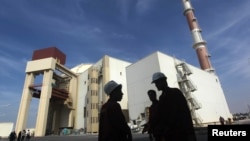Enriched uranium the deal talks about comes in two basic forms – uranium hexafluoride (UF6) and uranium dioxide (UO2).
Uranium hexafluoride (UF6) is a highly toxic compound that reacts violently with water and ‘eats’ most metals. It can relatively easily be converted to take gaseous, solid or liquid form. In gaseous form it can be inserted into centrifuges and enriched to weapons grade purity. In other forms it simply clogs the tiny holes in centrifuge cylinders.
Uranium dioxide (UO2) is a bit less dangerous, black, crystalline powder that was once also used for ceramic glazes.
Both compounds can be used for production of nuclear reactor fuel, but only UF6 in gaseous form can be enriched up to weapons grade level.
What Iran will retain
Iran will retain its ability to manufacture nuclear fuel for its reactors, but will not be allowed to enrich uranium to be suitable for nuclear weapons.
Under a November 2013 agreement, Tehran diluted or converted its stock of 20 percent enriched uranium gas (UF6), which could have been enriched further in its centrifuges to weapons grade. The weight of a nuclear weapon is inversely proportional to the purity of the nuclear explosive. In other words, a bomb with 20 percent enriched uranium would have to be huge.
According to the International Atomic Energy Agency, Iran has used 337 kg of its 20% enriched uranium gas to produce 162.8 kilograms of uranium oxide for use asnuclear fuel for its reactors. The oxide contains 20 percent enriched uranium, but must be converted back to gaseous form in order to make bomb fuel. The remaining amount of 5 percent enriched uranium is in various stages of conversion from gaseous UF6 to solid UO2. No reconversion will be allowed.
Iran will keep about one third of its 19,000 centrifuges. During the next 15 years they will be used for enrichment of uranium up to only 5 percent, good for nuclear reactor fuel, but too low for production of nuclear weapons.
Also, any newly produced enriched uranium will be converted to uranium dioxide (UO2) as it cannot be inserted into centrifuges for further enrichment.
The International Atomic Energy Agency estimates Iran now has 8,714.7 kilograms, or almost nine tons, of uranium gas (UF6) enriched up to 5 percent, plus an additional 151 kilograms of uranium oxide (UO2) also enriched to 5 percent.
Future of Iran's nuclear program
The nuclear deal says Tehran will not be allowed to continue operating or build any new facilities that convert uranium to UF6.
For the next six months, no amounts of uranium will be enriched to more than 5 percent, while all amounts of enriched UF6 will be converted to UO2.
Also, Iran will not be allowed to build any new facilities capable of reprocessing uranium. Tehran promises that it will not advance any activities in its uranium enrichment plants at Natanz and Fordow or its nuclear reactor at Arak.
Furthermore, Iran has agreed its nuclear activities will be subject to enhanced monitoring by the international community and it is obliged to submit detailed information on all of its nuclear activities within three months.









